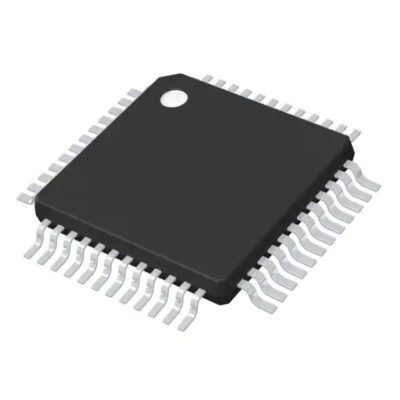STM32G070CBT6
Part Number: STM32G070CBT6
Manufacturer: STMicroelectronics
Description: IC MCU 32BIT 128KB FLASH 48LQFP
Shipped from: Shenzhen/HK Warehouse
Stock Available: Check with us
ICRFQ.com - Electronic Components Distributor in China Since 2003

Part Number: STM32G070CBT6
Manufacturer: STMicroelectronics
Description: IC MCU 32BIT 128KB FLASH 48LQFP
Shipped from: Shenzhen/HK Warehouse
Stock Available: Check with us
The STM32G070CBT6 microcontroller, which is based on the powerful Arm Cortex-M0+ core, is a flexible and integrated device made to handle a variety of applications in the consumer, industrial, and appliance sectors. The STM32G070CBT6 has a powerful feature set that makes it a good fit for Internet of Things (IoT) applications. These features include memory protection, high-speed embedded memories, advanced peripherals, and low-power capabilities. This in-depth guide will examine the main characteristics, capabilities, and potential uses of the STM32G070CBT6 microcontroller.
The STM32G070CBT6 microcontroller incorporates a range of system functions and peripherals to enhance its functionality and enable seamless integration into a variety of applications. Let’s explore the key features in this section:
I2C, SPI/I2S, and USARTs are among the common communication interfaces offered by the STM32G070CBT6. These interfaces are essential for enabling connectivity with peripherals and other devices.
I2C is a well-liked two-wire serial communication standard that permits data transfer between the microcontroller and other components, including sensors, displays, and memory chips.
Serial Peripheral Interface (SPI) and Integrated Interchip Sound (I2S) are two synchronous data transfer interfaces that are frequently used to send data between a microcontroller and external components such as sensors, display controllers, and audio codecs.
Universal Synchronous/Asynchronous Receiver/Transmitters, or USARTs, are devices that offer versatile serial communication capabilities and can support both synchronous and asynchronous communication protocols. They are frequently used to link devices together, including modems, GPS units, and other microcontrollers.
The STM32G070CBT6 microcontroller is equipped with a 12-bit ADC with a significant number of channels, allowing accurate analog-to-digital conversions.
The STM32G070CBT6 features a low-power RTC, which plays a critical role in timekeeping applications.
The STM32G070CBT6 microcontroller incorporates various timers that contribute to precise timing, control, and data acquisition.
These system functions and peripherals greatly enhance the capabilities of the STM32G070CBT6 microcontroller, enabling developers to implement precise timing, efficient data acquisition, and seamless connectivity in their applications.
High levels of integration are provided by the STM32G070CBT6 microcontroller, which combines key components on a single chip. It has embedded memories like 36 Kbytes of SRAM for effective data handling and 128 Kbytes of Flash program memory for storing the application code. A memory protection unit (MPU) is also included, which improves data security by shielding particular memory regions from unwanted access or change. The MPU ensures software robustness, system stability, and data integrity, which helps to increase the microcontroller’s overall security and dependability.
By enhancing dynamic consumption and implementing power-saving modes, the STM32G070CBT6 microcontroller addresses the significance of power efficiency in IoT devices. It features a number of power-saving settings like Sleep, Stop, and Standby that selectively turn off parts to save energy usage while the device is not in use.
The real-time clock (RTC) and backup register data are guaranteed to be retained during power outages thanks to the addition of a VBAT direct battery input. With these abilities, the STM32G070CBT6 is the best choice for energy-efficient IoT applications because it increases battery life, lowers power usage, and maintains crucial data integrity.
The STM32G070CBT6 microcontroller is appropriate for harsh situations since it operates in a wide temperature range (-40°C to 85°C). It allows for supply voltages ranging from 2.0V to 3.6V, giving power supply design flexibility. It is a dependable option for a variety of applications under difficult circumstances thanks to its strong temperature tolerance and voltage compatibility.
The STM32G070CBT6 microcontroller is adaptable and suitable for a variety of uses. Consumer electronics, industrial automation, household appliances, and Internet of Things (IoT) gadgets all use it. It is appropriate for a variety of projects thanks to its extensive feature set, which includes memory protection, communication ports, an ADC, timers, and low-power modes. Its adaptability and skills allow for reliable operation, efficient operation, and seamless connectivity across several domains.
In summary, the STM32G070CBT6 microcontroller is a potent IoT application solution. It provides the key features required for IoT development with its high-performance core, wide integration, adaptable peripherals, and power-saving capabilities. Its standard communication interfaces—analog to digital converter (ADC), timers, and low-power real-time clock (RTC)—offer seamless connectivity, exact data capture, precise timing, and sparing power consumption. The microcontroller is appropriate for a variety of applications due to its wide temperature range, compatibility with different voltages, and adaptability. Bring your IoT ideas to life by exploring the STM32G070CBT6 microcontroller’s possibilities now. To learn more and begin your electronic adventure, get in touch with ICRFQ.
WhatsApp us